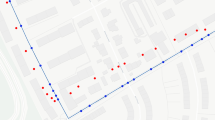Abstract
Dynamic traffic assignment (DTA) is at the heart of much ITS research. Assigning traffic, whether for planning purposes or for real time route guidance, is a difficult problem. Recent advances in user-optimal dynamic traffic assignment have built on the methods developed for static user-optimal assignments. Since assignment models are complex, they will not use many of the network analysis functions found in commercial GIS packages. Custom software will have to be developed. In this paper we explore the problems faced in solving static and dynamic assignments and relate those problems to information that is likely to be based in a traffic control center’s GIS database. Because of the size of the problem and the need for faster-than-real-time analysis, how and when data is transferred between a GIS to analysis modules is important. Further, many approaches for GIS software design and spatial data handling, such as OOP and dynamic segmentation, may impose too much overhead to be of much use in time-sensitive ITS applications.
Similar content being viewed by others
References
H.Z. Aashtiani and T.L. Magnanti. “Equilibria on a congested transportation network,” Siam Journal on Algebraic and Discrete Methods, Vol. 2:213–226, 1981.
M. Abdulaal and L.J. LeBlanc. “Methods for combining modal split and equilibrium assignment models,” Transportation Science, Vol. 13:292–314, 1979.
M. Ben-Akiva, M. Bierlaire, R. Mishalani, and H. Koutsopoulous. “DynaMIT: Dynamic Network Assignment for the Management of Information to Travelers,” URL:http://its.mit.edu/projects/dta/ dynamit.html, 1998.
S. Dafermos. “The general multimodal equilibrium problem with elastic demand,” Networks, Vol. 12:57–72, 1982.
M. Florian. “An improved linear approximation for the network equilibrium ( packet switching) problem,”. in Proc. IEEE Decision and Control Conference, 812–818, 1977.
T.L. Friesz, R.L. Tobin, T.E. Smith, and P.T. Harker. “A nonlinear complementarity formulation and solution procedure for the general derived demand network equilibrium problem,” Journal of Regional Science, Vol. 23:337–359, 1983.
G. Gallo and S. Pallottino. “Shortest path methods in transportation models,” in Transportation Planning Models. M. Florian, (Ed.) Elsevier Science Publishers, 227–256, 1984.
M. Goodchild. “Integrating GIS and spatial data analysis: Problems and possibilities,” IJGIS, Vol. 6:407–423, 1992.
R. Jayakrishnan, W.K. Tsai, and A. Chen. “A dynamic traffic assignment model with traffic-flow relationships,” Transportation Research C, Vol. 3:51–72, 1995.
B. Jansen. “Convergent algorithm for dynamic traffic assignment,” Transportation Research Record, Vol. 1328:69–80, 1991.
B. Jansen and J. Robles. “Quasi-dynamic traffic assignment model,” Transportation Research Record, Vol. 1493:199–206, 1995.
H. Miller. “GIS design for multimodal network analysis,” Proc. of GIS/LIS, 750–759, 1995.
B.A. Ralston. “Transportation Models, Geographic Databases, and Map Processing Models,” Paper presented at the 85th Annual Meeting of the Association of American Geographers, 1989.
B.A. Ralston. “Object oriented spatial analysis,” in GIS and Spatial Analysis. S. Fotheringham, P. Rogerson (Eds.), Taylor and Francis, 165–185, 1994.
B.A. Ralston, G. Tharakan, and C. Liu. “A spatial decision support system for transportation policy analysis,” Journal of Transport Geography, Vol. 2:101–110, 1994.
K.N.A. Safwat and T.L. Magnanti. “A combined trip generation, trip distribution, modal split, and trip assignment model,” Transportation Science, Vol. 18:14–30, 1988.
R. Steinberg and W.I. Zangwill. “The prevalence of Braess' paradox,” Transportation Science, Vol. 17:301–318, 1983.
T. Van Vuren and G.R.M. Jansen. “Recent developments in path finding algorithms: A review,” Transportation Planning and Technology, 1988, Vol. 12:51–71, 1988.
J.G. Wardrop. “Some theoretical aspects of road traffic research,” Proc. Institute of Civil Engineering, Part III, Vol. 1:325–378, 1952.
B.-W. Wie, R.L. Tobin, D. Bernstein, and T.L. Friesz. “A comparison of system optimal and user-optimal dynamic traffic assignments with schedule delays,” Transportation Research C, Vol. 3:389–411, 1995.
Author information
Authors and Affiliations
Rights and permissions
About this article
Cite this article
Ralston, B.A. GIS and ITS Traffic Assignment: Issues in Dynamic User-Optimal Assignments. GeoInformatica 4, 231–243 (2000). https://doi.org/10.1023/A:1009884408801
Issue Date:
DOI: https://doi.org/10.1023/A:1009884408801




